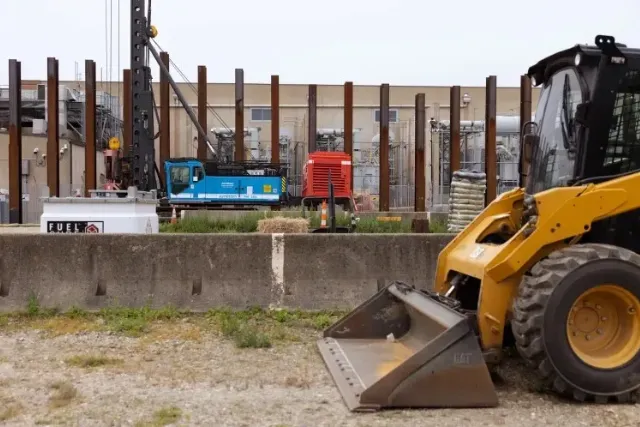
BRIDGEPORT, Conn. — More than a decade after Superstorm Sandy pushed nearly a 10-foot storm surge into Bridgeport’s South End, United Illuminating (UI) is taking a major step to protect one of the region’s most vital pieces of electric infrastructure.
The company has broken ground on a 16-foot-high steel floodwall around its Singer Substation to prevent future stormwaters from knocking out power to tens of thousands of homes and businesses.

“The water level got to under the door and we had people stay here, getting ready to open up circuits,” recalled Ben Acampora, a construction chief for UI, describing the tense hours in 2012 as the floodwaters approached.
The Singer Substation, located in a coastal floodplain, has long been vulnerable to severe storms. In fact, it was threatened not only by Sandy in 2012 but also by Hurricane Irene a year earlier. While both storms left the station largely unscathed, the damage to other parts of Connecticut served as a warning of what could happen if future floodwaters rise just a little higher.
The Singer Floodwall Project, expected to be completed in 2027, will cost $47 million and is part of a broader $146 million UI initiative to protect coastal substations.
Last year, UI completed a similar wall around the Congress Street Substation in Bridgeport. Another is planned for the Grand Avenue/Mill River Substation in New Haven, scheduled for completion in 2028.
Renni Pavolini, UI’s unit manager of substation projects, said damage to Singer could be devastating:
“We will have to shut down the substation, and depending on the damage… it could take days, or it could be just hours,” Pavolini said. “Our system, the grid, it’s done in a way that if this [station] is down, we probably could feel it with other substations.”

The floodwall is designed to withstand FEMA’s 100-year flood event, plus an additional three feet of water.
Construction began with crews driving 57 king pile beams into the bedrock surrounding the station, creating the skeletal framework. Steel sheet piles are now being installed between the beams to form the barrier. Two heavy-duty gates will allow access for workers but can be sealed quickly during storms.
Once structural work is complete, the wall will be coated in concrete for durability and aesthetics, and topped with a security fence.
Utilities nationwide are ramping up climate adaptation measures. Connecticut’s other major electric utility, Eversource, has invested $9.5 million since 2019 in flood protection for five substations, with more upgrades planned. Some coastal stations in Guilford, Branford, and Madison have been removed from service entirely due to flooding risks.
“We have a granular analysis so we understand the impact to specific assets,” said Elli Ntakou, Eversource’s manager of system resilience and reliability. “The specific stations that we think are higher risk, that’s where we target our mitigations so we make it cost efficient.”
The urgency is reinforced by the National Climate Assessment, which found that climate change is increasing the frequency and cost of extreme-weather-related power outages. By 2090, the report projects electricity transmission and distribution costs could rise an additional 25% due to climate impacts.
Bridgeport Harbor’s concentration of substations, transmission lines, and power plants makes it a high-risk area for electrical disruptions. The Resilient Bridgeport Project — a broader flood defense initiative for the South End — was slated to receive more than $47 million in FEMA funds before federal grant cuts halted the plan earlier this year.
While that project’s future remains uncertain, UI’s Singer floodwall is moving forward without federal assistance. Funding comes directly from customer utility rates, spread across transmission and distribution bills.
In addition to the flood protection projects, UI recently completed the $142 million Pequonnock Substation on higher ground, replacing an older, more vulnerable facility.
The Singer floodwall and other mitigation efforts are not just about protecting infrastructure — they’re about keeping the lights on for thousands of households and businesses during increasingly severe storms.
As Pavolini notes, the stakes are high: one major failure at a transmission station like Singer could ripple far beyond Bridgeport, impacting communities across southern New England.
Originally reported by John Moritz in Hartford Courant.